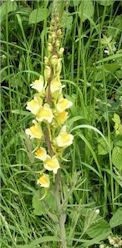|

Toadflax |
The Toadflax, or Flaxweed (Linaria vulgaris) belongs to the scrofula-curing order of plants, getting its name from linum, flax, and being termed "toad" by a mistaken translation of its Latin title Bubonio, this having been wrongly read bufonio,--belonging to a toad,--or because having a flower (as the Snapdragon) like a toad's mouth: whereas "bubonio" means "useful for the groins."
It is an upright herbaceous plant most common in hedges, having leaves like grass of a dull sea green aspect, and bearing dense clusters of yellow flowers shaped like those of the garden Snapdragon, with spurs at their base. It continues in flower until the late autumn. The Russians cultivate the Snapdragon for the oil yielded by its seeds.
The Toadflax has a faint disagreeable smell, and a bitter saline taste. It acts medicinally as a powerful purge, and promoter of urine, and therefore it is employed for carrying off the water of dropsies, being in this respect a well known rural Simple. Waller says: |
"Country people boil the whole plant in ale, and drink the decoction; but the expressed juice of the fresh plant acts still more powerfully."
In many districts the herb is familiarly known as "butter and eggs;" and in Germany though dedicated to the Virgin it is called "devil's band."
Again in Devonshire it goes by the names of "Rambling," or "Wandering Sailor," "Pedler's Basket," "Mother of Millions" (the ivy-leaved sort), "Lion's Mouth" and "Flaxweed."
When used externally an infusion of the herb acts as an anodyne to subdue irritation of the skin, and it may be taken as a medicine to modify skin diseases. The fresh juice is attractive to flies, but at the same time it serves to poison them: so if it be mixed with milk, and placed where flies resort they will drink it and perish at the first sip.
As promoting a free flow of urine, the herb has been named "Urinalis," or sometimes "Ramsted." The flowers contain a yellow colouring matter, mucilage, and sugar. In Germany they are given with the rest of the plant for dropsy, jaundice, piles, and some diseases of the skin. Gerard says: "The decoction openeth the stoppings of the liver, and spleen: and is singular good against the jaundice which is of long continuance." He advises an ointment made from the plant stampt with
lard for certain skin eruptions, and a decoction made with four drachms of the herb in eight ounces of boiling water. The bruised leaves are useful externally for curing blotches on the face, and for piles.
An old distich says of the Toadflax as compared with the Larkspur:--
"Esula lactescit: sine lacte Linaria crescit;"
or,
"Larkspur with milk doth flow:
Toadflax without milk doth grow,"
(alluding to the dry nature of the toadflax). To which the Hereditary Marshal of Hesse added the following line:
"Esoula nil nobis, sed dat linaria taurum,"
implying that the herb was of old valued for its good effects when applied externally to piles as an ointment, a fomentation, or a poultice, each being made from the leaves and the flowers. The originator of this ointment was a Dr. Wolph, physician to the Landgrave of Hesse, who only divulged its formula on the prince promising to give him a fat ox annually for the discovery.
Herb Simples
The Primitive Simplers presented here show the way of life in other generations, it is not suggested or recommended trying them yourself. |
|
Garden
Herbs
Home
History of Herbs
Herb Gardening
Herbs for Beginners
Drying & Preserving Herbs
Indoor Herb Gardening
Herb Garden
Hints & Tips
Herbal
Cooking
Herb Chart
Using Herbs
Culinary Herbs
Herb
Oil and Vinegar
Herb Teas
Herb Candy
Herb Jelly
Herb Simples
Preface
Introduction
Alphabetical Listing

Trade
Recipes Online
Share your Recipes with others!!
|


